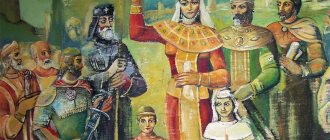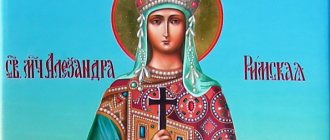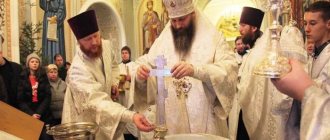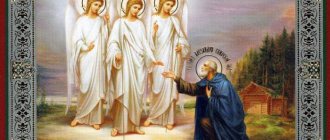| Passion-bearer Alexandra Feodorovna |
Alexandra Feodorovna
(1872 - 1918), Empress of All Russia, blessed queen, passion-bearer [1].
The wife of the All-Russian Emperor Nicholas I is known under the same name and patronymic.
Commemorated on July 4 on the day of death, in the Councils of the New Martyrs and Confessors of the Russian Church, Ekaterinburg, Kostroma and St. Petersburg Saints
She was born on May 25, 1872 in Darmstadt, in the family of the Grand Duke of Hesse Ludwig IV and Grand Duchess Alice, née Princess of Great Britain and Ireland, the second daughter of Queen Victoria of England. She was baptized into Lutheranism with the name Alice Victoria Elena Brigitte Louise Beatrice. In addition to Princess Alice, the family of Grand Duke Ludwig IV had children: Victoria, Ella (future Grand Duchess Martyr Elizabeth Feodorovna), Ernst Ludwig, Irena. The children's upbringing was supervised by their mother, a highly educated woman known for her charitable activities. During the diphtheria epidemic, Grand Duchess Alice contracted the disease while caring for the sick and died at the age of 35 on December 14, 1878. Having lost her mother, Princess Alice lived with her grandmother, Queen Victoria, from the age of 6. At the English court, she received an upbringing and a varied education; she spoke and wrote fluently in several languages. The family called her “sunbeam” for her cheerfulness and beauty. In her youth, Princess Alice attended lectures at the Faculty of Philosophy at the University of Heidelberg, where she received a bachelor's degree in philosophy. The culture of journaling and correspondence characterized Princess Alice from childhood.
In June 1884, 12-year-old Princess Alice visited Russia for the first time, attending the wedding of her sister, Princess Ella, and Grand Duke Sergei Alexandrovich. In January 1889, at the invitation of Grand Duke Sergei Alexandrovich, the princess again came to Russia with her brother and father. The guests spent 6 weeks at the Sergius Palace in St. Petersburg. The young princess aroused deep feelings in the heir to the Russian throne, Tsarevich Nikolai Alexandrovich, but the imperial family hoped for a marriage between the Tsarevich and the royal family of France; they wanted to see Elena Louise Henrietta, the daughter of Louis Philippe Bourbon of Orleans, Count of Paris, as the heir's bride. In August 1890, Princess Alice visited Grand Duchess Elisaveta Feodorovna in Ilinskoye, but the Tsarevich was unable to see her. In 1894, the health of Emperor Alexander III Alexandrovich sharply deteriorated, and the issue of succession to the throne and the marriage of the crown prince was resolved quickly.
On April 2, 1894, Nikolai Alexandrovich went to Coburg to propose to Princess Alice. He was accompanied by Protopresbyter John Yanyshev, confessor of the imperial family in 1883-1910, who was supposed to teach the princess the basics of Orthodoxy. E. A. Schneider, the teacher of Grand Duchess Elisaveta Feodorovna, was assigned to teach Princess Alice the Russian language. On April 8 of the same year, the engagement took place; Princess Alice and Tsarevich Nicholas spent 12 days in Coburg, Darmstadt, and then a month in England. Princess Alice considered her engagement to be the happiest event in her life; all that remained was to resolve the issue of converting to Orthodoxy. The princess was very religious and did not dare to change her Lutheranism, but the persistence of her sister, Grand Duchess Elizabeth Feodorovna, who joined Orthodoxy after 8 years of marriage, helped. At the request of the Grand Duchess, Protopresbyter John Yanyshev lived for six months at the Hessian court, studying and talking with Princess Alice every day, and subsequently became her confessor.
In the fall of 1894, alarming news about the health of Emperor Alexander III began to arrive in Darmstadt; on October 5, the princess received a telegram urgently summoning her to Russia. On October 10, she arrived in Crimea, in Livadia, where she stayed with the imperial family until October 20, the day of the death of Emperor Alexander III. On October 21, in the church of the Livadia Palace, Princess Alice was received into the fold of the Orthodox Church through confirmation and named Alexandra Feodorovna in honor of the martyr Queen Alexandra. On November 14 of the same year, on the birthday of Empress Maria Feodorovna, when deviations from strict mourning were allowed, the wedding of Emperor Nicholas II and Alexandra Feodorovna took place in the church of the Winter Palace. On May 14, 1896, the coronation of the royal couple took place in the Assumption Cathedral of the Moscow Kremlin.
| Holy Empress Alexandra Feodorovna |
Empress of All Russia
The Empress strove to become “ a true helper in all respects.”
» to his autocratic husband.
Protopresbyter of the military and naval clergy Georgy Shavelsky wrote that the empress saw “ in the person of her husband the sacred Anointed of God.
Having become the Russian queen, she managed to love Russia above her first homeland ” [2].
Subsequently, historians noted the theoretical mind of the empress and called her letters, which covered in detail the state of the Russian court and St. Petersburg, “ historical material of paramount importance
” [3].
The crowned family became a model of a truly Christian, united family. The imperial couple had 4 daughters: passion-bearers Grand Duchesses Olga Nikolaevna (November 3, 1895), Tatiana Nikolaevna (May 29, 1897), Maria Nikolaevna (June 14, 1899), Anastasia Nikolaevna (June 5, 1901). On July 30, 1904, the long-awaited heir to the throne, begged from God, was born - the passion-bearer Tsarevich Grand Duke Alexy Nikolaevich, to whom the hereditary disease of the descendants of Queen Victoria was transmitted - hemophilia. The empress took care of the upbringing and education of children, passed on to them her culture of correspondence and diary-keeping, and her religiosity. It is no coincidence that the royal family, according to historians, is “among the best documented in history” [4]. In addition to written sources, more than 150 thousand photographs of the imperial family, in which everyone had a personal camera, have been preserved; More than a thousand albums with photographs are known [5].
The Empress took care of the health of all family members, especially her son. She conducted the initial training of the heir independently, later invited outstanding teachers to him and observed the progress of the teaching. Thanks to the empress's great tact, the Tsarevich's illness was kept a family secret. Constant concern for the life of Alexy became the main reason for the appearance at the court of G. E. Rasputin, who had the ability to stop bleeding with the help of hypnosis, so in dangerous moments of illness he became the last hope for saving the child. The maternal torment of the empress and the desire to maintain peace in the family on the part of the tsar determined the role of Rasputin in the life of the court.
According to contemporaries, the empress was deeply religious. The church was her main consolation, especially at a time when the heir’s illness worsened. Lady-in-waiting S.K. Buxhoeveden noted that Empress Alexandra believed “in healing through prayer,” which she associated with her origins from the House of Hesse from Elizabeth of Thuringia (Hungary) (1207-1231), who established hospitals in Marburg, Eisenach, and Wartburg in the name of Great Martyr George and Saint Anna and who treated lepers [6]. The Empress held full services in the court churches, where she introduced the monastic liturgical regulations. Alexandra Feodorovna’s room in the palace was “ a connection between the empress’s bedroom and the nun’s cell. The huge wall adjacent to the bed was completely covered with images and crosses
"[7]. Under the images stood a lectern covered with ancient brocade. In July 1903, Nicholas II and Alexandra Feodorovna took part in the celebration of the glorification and opening of the relics of St. Seraphim of Sarov; a shrine and a canopy for the relics were built at the expense of the imperial family. A year before this, the Empress sent a lamp and church vestments to the Sarov Hermitage with a request to serve a daily prayer service for her health in the chapel built over the grave of St. Seraphim. She was sure that thanks to the prayers of the saint, Russia would receive an heir [8].
Through the efforts of the imperial family, several Orthodox churches were erected. In the homeland of Alexandra Feodorovna, in Darmstadt, a temple was built in the name of St. Mary Magdalene in memory of the first Russian Empress from the House of Hesse, Maria Alexandrovna. On October 4, 1896, in Hamburg, in the presence of Nicholas II, Alexandra Feodorovna, Grand Duchess Elisabeth Feodorovna, the Grand Duke of Hesse, in memory of the coronation of the Russian Emperor and Empress, a temple was founded in the name of All Saints. At their own expense, the imperial family, according to the design of architects S. S. Krichinsky and V. A. Pokrovsky, created the Feodorovsky town in the Alexander Park of Tsarskoye Selo with a court cathedral in the name of the Feodorovskaya Icon of the Mother of God, consecrated on August 20, 1912, where a prayer room with a lectern and chair for the empress. The underground church in the name of St. Seraphim of Sarov was a true treasury of ancient icon paintings and church utensils; it contained the Gospel of Tsar Theodore Ioannovich. Under the patronage of the empress, committees worked on the construction of churches in memory of sailors who died in the Russo-Japanese War of 1904-1905, and the Holy Trinity Cathedral in Petrograd.
One of the first undertakings of the empress, who became famous for her charitable activities, was the patronage of the imperial women's Patriotic Society, according to a rescript from Emperor Nicholas II of February 26, 1896. An unusually hard worker who devoted a lot of time to needlework, the empress organized charity fairs and bazaars where homemade souvenirs were sold. Under her patronage there were many charitable organizations: the House of Diligence with training workshops for cutting and sewing and a children's boarding school; Society for Labor Assistance to Educated Persons; House of hard work for educated women; Olginsky shelter of hard work for children of persons being treated at the hospital of St. Mary Magdalene; Trusteeship of the Imperial Humane Society to collect donations for the vocational education of poor children; Labor Aid Society "Uley"; Tsarskoe Selo Society of Handicrafts and School of Folk Art for teaching handicrafts; All-Russian Guardianship for the Protection of Motherhood and Infancy; Brotherhood in the name of the Queen of Heaven in Moscow (with it there was a shelter for 120 children - feeble-minded, crippled, epileptic - with a school, workshops, and a craft department); Shelter-nursery of the 2nd Temporary Committee for the Protection of Motherhood and Infancy; Shelter named after Empress Alexandra Feodorovna in Harbin; nursery of the Peterhof Charitable Society; 4th Petrograd Committee of the All-Russian Guardianship for the Protection of Motherhood and Infancy with a shelter for mothers and a nursery; “Nanny School” in Tsarskoe Selo, established at the personal expense of the Empress; Tsarskoye Selo Community of Sisters of Mercy of the Russian Red Cross Society (ROSC) and the House of the Empress for the charity of crippled soldiers; Holy Cross Community of Sisters of Charity ROKK; 1st Petrograd Ladies' Committee of the ROCC; Mikhailovsky, in memory of General M.D. Skobelev, a society for medical assistance to low-income wives, widows, children and orphans of soldiers (it had an outpatient clinic, an inpatient department, and a shelter for girls - orphans of soldiers); All-Russian Alexander Nevsky Brotherhood of Temperance (it has a school, a kindergarten, a holiday village, a book publishing house, folk choirs).
| Empress Alexandra Feodorovna, sister of mercy |
During the Russo-Japanese War, Alexandra Feodorovna personally prepared ambulance trains and warehouses of medicines to be sent to the theater of military operations.
The Empress suffered the greatest hardships during the First World War. Since the beginning of the war, Alexandra Feodorovna and her eldest daughters took courses in caring for the wounded in the Tsarskoye Selo community. In 1914-1915, the imperial train visited Moscow, Luga, Pskov, Grodno, Dvinsk (now Daugavpils), Vilna (now Vilnius), Kovno, Landvarovo, Novo-Sventsyany, Tula, Orel, Kursk, Kharkov, Voronezh, Tambov, Ryazan , Vitebsk, Tver, Likhoslavl, Rzhev, Velikiye Luki, Orsha, Mogilev, where the empress and her children visited wounded soldiers. Special trains were created for the empress's mobile and field warehouses. At each warehouse there was a camp church and a priest. To provide material support to wounded soldiers and their families, the Supreme Council for Charity of the Families of Persons Called up to the War, as well as the Families of Wounded and Fallen Soldiers, and the All-Russian Society of Health Resorts in Memory of the War of 1914-1915 were established. Under the patronage of the empress there were infirmaries: at the House of Diligence named after E. A. Naryshkina; at the Petrograd Orthopedic Institute; at the Mikhailovsky Society in memory of M.D. Skobelev and others. The Empress's Warehouse Committee worked in the Winter Palace from 1914 to 1917. Of exceptional interest for Russian culture, history, and science are objects of palace life, collections of antiquities, collections of books and works of art compiled by the empress and the august family. All imperial orders intended for palaces were unique, and duplicates were not allowed. The library of the Empress and Grand Duchesses in the Winter Palace consisted of about 2 thousand volumes, and manuscripts were also kept there. Alexandra Feodorovna’s books were also in Livadia, Tsarskoye Selo, they are marked with a bookplate and are works of publishing and bookbinding art. The support of Alexandra Feodorovna and the entire imperial family of the Faberge firm became a prerequisite for the emergence of a new direction in applied art - the “imperial style”, “Faberge design and style”. The Empress collected antiquities and assisted scientists. She received an honorary diploma from the Archaeological Institute, the committee for the construction of the Museum of Fine Arts named after Emperor Alexander III in Moscow elected her an honorary member for her active assistance to the museum, and the Pergamon Hall of the museum was named in honor of the empress. Under the patronage of the empress was the Imperial Society of Oriental Studies, which had the goal of “ distributing accurate and correct information about Russia among the eastern peoples, as well as familiarizing Russian society with the material needs and spiritual life of the East.”
" Alexandra Feodorovna was a skilled artist; icons embroidered by her were preserved in the Church of St. Mary Magdalene in Darmstadt. By the beginning of 1903, she made drawings of a Russian costume for a charity ball in the Winter Palace, in consultation with the director of the Hermitage I. A. Vsevolozhsky. The Empress was dressed in gold brocade clothes, created according to sketches from the clothes of Tsarina Maria Ilyinichna. Another work of Alexandra Feodorovna is a drawing of a sign for parts of the imperial convoy. The Empress collected works of laminated glass and personally gave production instructions to the imperial porcelain and glass factories.
In the last years of her reign, especially during the First World War, Alexandra Feodorovna became the subject of a ruthless and baseless slander campaign led by revolutionaries and their collaborators in both Russia and Germany. Rumors were widely spread about the empress's adultery, about her allegedly unchaste relationship with Rasputin, about her betrayal of the Motherland in favor of Germany. This lie, whipped up in order to overthrow the royal house and embarrass the Russian people, at one time became widespread not only in popular but also in scientific publications. However, despite the fact that the sovereign knew about the purity of the empress’s personal life, he also personally ordered a secret investigation into “slanderous rumors about the empress’s relations with the Germans and even about her betrayal of the Motherland.” Although in the pre-war period the Empress did support improving relations with Germany, it was established that rumors about the desire for a separate peace with the Germans, the transfer of Russian military plans by the Empress to the Germans, were spread by the German General Staff. After the abdication of the sovereign, the Extraordinary Commission of Inquiry under the Provisional Government tried and failed to establish the guilt of Nicholas II and Alexandra Feodorovna of any crimes.
However, the denigration of the image of the royal family, the widespread loss of faith and loyalty to it, and the obvious desire of broad layers of the empire's elite to abandon the monarchical structure of the state led to the removal of the imperial family from power. On March 2, 1917, Emperor Nicholas II abdicated the throne for himself and for Tsarevich Alexy.
Imprisonment and martyrdom
On March 8, 1917, by order of the Provisional Government, the empress and her children were arrested by General L. G. Kornilov in Tsarskoe Selo, on the same day the sovereign was arrested in Mogilev, and on March 9 he was taken to Tsarskoe Selo under escort. On August 1 of the same year, the royal family left the Alexander Palace of Tsarskoye Selo for exile in Tobolsk, where they lived for 8 months in prison in the governor’s house.
In captivity, Alexandra Feodorovna taught children the Law of God, foreign languages, was engaged in needlework, painting, and reading spiritual books. Common prayer united the family, whose life was determined by faith, hope and patience. Surrounded by enemies, the prisoners turned to spiritual literature, strengthened themselves with the examples of the Savior and the holy martyrs, and prepared for martyrdom. While in prison, the Empress gave the children books: “The Life and Miracles of the Holy Righteous Simeon of Verkhoturye”, “The Life of Our Reverend Father Seraphim of Sarov”, “Consolation in the Death of Those Close to the Heart”, “On the Patience of Sorrows”, “The Benefits of the Mother of God to the Human Race Through Her Saints” icons." Numerous notes in the books, especially in the books of the empress, testified to the high spiritual state of the royal family - faith, humility, forgiveness, the desire to be faithful to the covenants of the Lord [9]. Among Alexandra Feodorovna’s books were “The Ladder” by St. John Climacus, “On the Patience of Sorrows, the Teaching of the Holy Fathers, collected by Bishop Ignatius Brianchaninov,” a Prayer Book and the Bible [10].
On April 26, 1918, the sovereign, empress and Grand Duchess Maria Nikolaevna, by order, left Moscow for Yekaterinburg, leaving them in the care of the older sisters of the sick Alexy; on April 30, they were imprisoned in a house that previously belonged to engineer N.K. Ipatiev. The Bolsheviks called it a “house of special purpose” and the prisoners - “tenants”. The house, surrounded by a high fence, was guarded by more than 30 people. On May 23, at 2 o'clock in the morning, Grand Duchesses Olga, Tatiana, Anastasia and Grand Duke Alexy were also taken to Yekaterinburg. The life of the royal family was subject to the prison regime: isolation from the outside world, meager food rations, an hour-long walk, searches, hostility from the guards.
On July 12, under the pretext of the Czechoslovak Corps and units of the Siberian Army approaching Yekaterinburg, the Bolshevik Urals Council adopted a resolution to kill the royal family. There is an opinion that the military commissar of the Urals F.I. Goloshchekin, who visited Moscow at the beginning of July 1918, received V.I. Lenin’s consent to this. On July 16, a telegram was sent to Lenin in which the Urals Council reported that the execution of the royal family could no longer tolerate delay, and asked to immediately inform whether Moscow had any objections. Lenin did not respond to the telegram, which the Urals Council may have considered as a sign of agreement. The leadership of the execution of the resolution was taken over by Ya. M. Yurovsky, who on July 4 was appointed to the post of commandant of the “special purpose house.”
During this tragic time, the empress was distinguished by extraordinary greatness of spirit and “ amazingly bright calm, which then supported her and her entire family until the day of their death.”
" [eleven].
On July 16, a few hours before the execution, she wrote in her diary: “ Tatiana was reading spiritual literature.
Everybody left. Tatyana stayed with me and read: the holy prophet Amos and the prophet Obadiah " [12].
The murder of the royal family and their entourage followed on the night of July 16-17, 1918. At 2 a.m., the prisoners were woken up and ordered to go down to the semi-basement floor of the house, where the royal family was shot by armed executioners from the Cheka. According to their testimony, the empress and eldest daughters managed to cross themselves before their death. The Tsar and Empress were killed first. They did not see the execution of their children, who were finished off with bayonets. Commissar of Supply of the Ural Region P.L. Voikov, who stole the ruby ring donated by the sovereign from the body of the empress, delivered sulfuric acid and gasoline to destroy the bodies of those killed in the old mine shafts of the Four Brothers tract.
| Royal New Martyrs. |
About God and life by faith
True faith is manifested in all our behavior. It's like the sap of a living tree that reaches the farthest branches.
We know that when He denies us our request, then fulfilling it would be to our harm; when He does not lead us along the path we have planned, He is right; when He punishes or corrects us, He does it with love. We know that He does everything for our highest good.
Let others see from the example of your life that faith is more than doctrine or observance of rituals.
The remembrance of past mercies will support faith in God in the trials to come.
Do not lose heart, but calmly trust in the will of God, and, no matter what befalls you, endure everything for the glory of the Lord, since after winter comes summer, after night comes day, and after storm comes silence.
The Messiah is called the Servant of God many times in the Old Testament. Service is not something base, it is Divine.
If our love is true and sincere, we always trust in heaven.
What is prayer? This is when we are close to Christ.
Religion makes some people stern and gloomy. But this is not Christian. The religion inspired by the word of Christ is sunny and joyful.
Joy is the hallmark of a Christian. A Christian should never become discouraged; he should never doubt that good will triumph over evil.
If the word of Christ lives in us, it will compel us to help others.
How does the icon of the Romanov royal family help?
For each person bearing the name of one of the royal passion-bearers, he (or she) will become their patron saint. These names are: Nikolai, Alexandra, Alexey, Olga, Tatyana, Maria and Anastasia.
Prayer in front of such an icon helps to maintain mutual respect between generations and close relationships between relatives, raise children in piety, loyalty to Orthodox principles and patriotism, and prayer in front of the miraculous myrrh-streaming icon of Nicholas II helps to find healing.
Veneration of the icon “Romanov Passion-Bearers” July 4/17 – the day of the death of the royal family and January 25/February 7 – Celebration of the Council of New Martyrs who suffered for the Christian faith after the 1917 revolution.
About man and virtues
We must become real people.
To be great is to be happy - this is one of the erroneous opinions that most of humanity has held at almost all times. To be kind means to be happy - this is a secret accessible to those few wise and virtuous who are an adornment not only to themselves, but also an adornment to their neighbors and the Fatherland.
The soul writes its history on the body.
The more humble a person is, the more peace there is in his soul.
Humility is not about talking about your shortcomings, but about enduring others talking about them; in listening to them patiently and even gratefully; in correcting the shortcomings that we are told about; is not to feel hostility towards those who tell us about them.
When doing charity, it is important not to drown in self-esteem.
The basis of a noble character is absolute sincerity.
Purity of thoughts and purity of soul are what truly ennobles.
Encouragement inspires us; if it is not there, many noble opportunities are extinguished.
True wisdom does not consist in the assimilation of knowledge, but in the correct application of it for good.
The first lesson to learn and execute is patience.
If everything is good inside, then nothing will harm the outside.
If you are aware of what you are, you will not pay attention to what people say about you.
Be courageous - that's the main thing.
True virtue is to act without witnesses as one usually acts before the eyes of the world.
Trust your heart, especially when this trust is good, listen to it.
Anyone who has done good should not talk about it, but if they boast about it, goodness loses its nobility...
Give without looking for anything in return, without calculating benefits in the future; give to children, the elderly, the dying, those who cannot repay, and those whom you will never see again, otherwise it will not be a benefit, but a bargain; try to help even your enemies. Do not trust the distribution of your alms to dubious intermediaries, otherwise the very act, which the Apostle called “labor of love” (1 Sol. 1:3), will be in doubt. With your own hand, do what your heart tells you. In this way you will become acquainted with the life and needs of the poor - the creatures of Christ.
The longer I live, the more clearly I understand that the main difference between people strong and weak, great and insignificant is energy, invincible determination, a firm goal, in which even death is victory.
A person is never so beautiful as when he prays for his own forgiveness or the forgiveness of another.
Morality is what determines the meaning of any action - vain or otherworldly meaning.
The most difficult thing a person must overcome is himself.
Spiritual feat of the Roman queen
At the beginning of the 4th century, the emperor of the Roman Empire was Diocletian, a persecutor and tormentor of Christians. He was the main tormentor of St. George the Victorious. From his life, the name of the emperor’s wife, who secretly professed Christianity, became known.
Holy Martyr Queen Alexandra
Queen Alexandra witnessed many miracles that were revealed in response to the prayers of the Great Martyr George. Seeing the fortitude, courage and fortitude of the holy warrior, accepting suffering for his Faith, the emperor’s wife made her way through the crowd of onlookers to the place of torture of the former Roman soldier, fell at his feet and publicly confessed her commitment to the Christian Church.
Relationships between people. Love, family
The life of humanity is a large common life of individual human creatures. It must be understood that the existence of one person separately from all other people is the same as if a person existed separately from the cells of his own body.
Each person has a sacred responsibility for the happiness and highest good of the other until the end of his life.
We must try to ensure that everything we do, our whole life, is for the benefit of other people. We must live in such a way that we do not harm anyone, so that our life serves as an example for others.
Trying to make your neighbors happy is the path to your own happiness.
Most arguments between people are pointless. They are caused either by the intervention of strangers, or by frivolous words, or by the action of unrepentant sins.
What people around us need most is just kindness.
Kind words always connect.
No one deserves a greater reward than peacemakers.
The possibilities of helping people simply by talking to them are almost endless. One who knows how to speak with conviction, knows how to speak the language of love, can inspire others to good and wonderful deeds, console their grief, cheer up those who are discouraged, enlighten those who are inexperienced - can help others in a thousand ways.
Adversity is a time when you need to support your neighbor.
There are many people in the world who have fallen into despair, and we must be able to tell them a word of hope or do a good deed that will lead them out of hopelessness and give them strength to return to a joyful, full life.
He who stops helping others becomes a burden to himself.
Every new friend who comes into our lives trusts us. The most correct concept of friendship is that it gives us the opportunity to serve, help, protect another. The moment we make a new friend is a sacred moment. This is another life entrusted to us so that we can be a blessing to it, bring beauty to it, be its refuge and protection.
Fill your days with love. Forget yourself and remember others. If someone needs your kindness, then show this kindness immediately, now... If your heart longs for words of encouragement, gratitude, support, say these words today.
One word covers everything - the word “love”. The word “love” contains a whole volume of thoughts about life and duty, and when we study it closely and carefully, each of them appears clearly and distinctly.
How sweet are the words of Truth, carried by the breath of love.
Only that life is worthy in which there is sacrificial love.
Jesus demands love not only as a wonderful feeling, but as a love that permeates all daily life, affecting relationships with all people.
There cannot be deep and sincere love where selfishness rules. Perfect love is perfect self-denial.
Life is too short to waste it fighting and arguing, especially within the sacred circle of family.
As long as you love, you forgive.
Marriage is a Divine rite. He was part of God's plan when He created man. This is the closest and most sacred connection on earth.
Love does not grow, does not become great and perfect suddenly and on its own, but requires time and constant care.
Love requires special delicacy. You can be sincere and devoted, and yet your speeches and actions may lack that tenderness that so captivates hearts... The closer the relationship, the more painful the heart is from a look, tone, gesture or word that speaks of irritability or is simply thoughtless.
Without purity it is impossible to imagine true femininity. Even in the midst of this world, mired in sins and vices, it is possible to maintain this holy purity.
You can tell what a woman is like by the home she creates.
A woman is endowed with the gift of sympathy, delicacy, and the ability to inspire. This makes her seem like a messenger of Christ with a mission to alleviate human suffering and sorrow.
How you treat women is the best way to test a man's nobility.
Parents should be what they want their children to be - not in words, but in deeds. They must teach their children by the example of their lives.
Childhood songs are never forgotten. Memories of them lie under the burden of years filled with worries, like delicate flowers under the snow in winter.
The importance of the environment is vital. We do not yet fully understand how much the atmosphere in the home where children grow up means for the development of their character. The very first place for us where we learn truth, honesty, love is our home - the most dear place for us in the world.
History of the icon
The sin of murdering God’s anointed one weighed heavily on Russia for many decades, and only at the turn of the millennium, in 2000, the murdered Emperor Nicholas II and his family were canonized by the Russian Orthodox Church as royal martyrs. To glorify the new saints, icons of the Romanov royal family appeared.
However, the icon of the Romanovs serves not only to glorify the innocent murdered, but also for the repentance of the people guilty of the sin of apostasy from God’s anointed and leaving him along with innocent children in the hands of enemies. This sin is aggravated by the fact that neither the family nor those close to them during the arrest and detention tried to resist, humbly accepting the Will of God with Christian meekness. This sin, which still weighs heavily on Russia, will have to be atone for more than one generation.
Therefore, it is not surprising that today the icon of the holy royal passion-bearers is in almost every Orthodox church, and many believers have it in their homes. This is the meaning of the icon of the royal martyrs - to remind all of us, both believers and non-believers, of the martyrdom of the royal family, which was accomplished in the name of peace on Russian soil and once again confirmed the inviolability of the foundations of Orthodoxy in the Russian state.
Life. Pacification
Every day is life in miniature.
We often lose what is dear to us, chasing the unattainable.
How many opportunities we miss to do good without even realizing the value of what we missed!
Due to constant troubles and worries, we do not reveal even half of the good that is in us.
The meaning of life is not to do what you like, but to do what you should do with love.
Go forward, make mistakes, fall and get up again, just keep going.
Often more heavenly grace is required for ordinary things than for great ones.
No person is so poor that he can consider himself like that. Wisdom is for a person to allow the Lord to decide everything for him.
Everyone has their place, and everyone is important in their place. The smallest and most insignificant also have their places, and it is necessary that these small places be filled as well as the places occupied by the most important and significant individuals.
Never lose heart and never let others lose heart.
We are creators. Human lives are everywhere, like unfinished buildings, and everyone who passes by places a brick on the wall or adds some decoration. Everyone with whom we come into contact, who speaks even a word to us, who even influences us from afar, leaves in our character a touch of beauty or a sign of something bad.
We must remain in our place, do our duty, bear our burden, do God's will. This is the path to peace of mind.
The peace that the Lord gives us is peace of the soul - not external peace, not idleness. One can enjoy it to the fullest, and at the same time continuously work and endure suffering and pain. Some of the best Christians the world has ever known were the greatest sufferers, but at the same time, nothing could disturb their peace of mind.
Only those who have peace in their souls can do their jobs well. A restless mind is not suitable for good work.
Worry makes us weak.
An irritated mind cannot think clearly.
Peace is a Divine gift, but at the same time, we must learn it. Learn by taking upon yourself the yoke of Christ.
The kindest thing a teacher can do for his students is to teach them to lead a life of faith and courage - a life of winners.
Iconography
The iconography of the holy martyr Queen Alexandra of Rome includes several common types:
- half-length single images;
- individual full-length icons;
- multi-figure iconographic compositions.
Icon of Queen Alexandra of Rome
In most images the saint is dressed in royal robes. The head is crowned. The empress's right hand is occupied by a cross, and her left is either pressed to her chest or with her palm facing the audience. Most often, single images of the queen are located on a golden background. In some icons, city walls and a river can be seen in the background.
Multi-figure compositions with the participation of the holy martyr Alexandra can be seen in the following museums and churches:
- full-length mosaic image in the iconostasis of St. Isaac's Cathedral in St. Petersburg;
- mosaic in the Church of the Savior on Spilled Blood;
- icon of St. Nicholas the Wonderworker and St. Queen Alexandra of Rome in the Hermitage;
- The icon “Selected Saints”, kept in the Andrei Rublev Museum of Ancient Russian Art.









